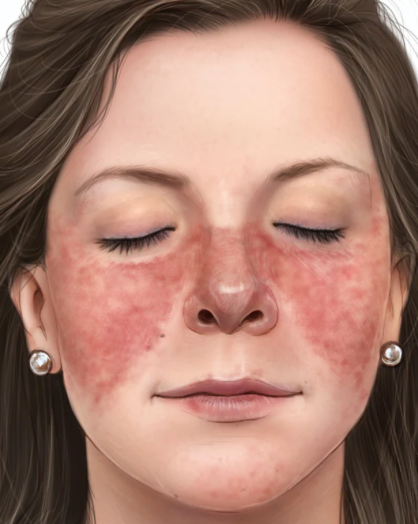What is lupus and what are its dermatological impacts?
- skinwfa
- Aug 24, 2024
- 2 min read
By Emma Silshtut

Lupus, also lupus erythematosus, is an autoimmune disease which causes inflammation in different body systems such as joints, blood cells, and organs. A common symptom of Lupus is a malar rash also known as a butterfly rash because of the red lesion that spreads along the nose and the cheeks creating a butterfly on the face.
There are four different types of Lupus: systemic lupus erythematosus (SLE), cutaneous lupus erythematosus (CLE), neonatal lupus, and drug-induced lupus. All the types of lupus have a dermatological impact on the body through the appearance of a rash, but the main difference between the types of lupus is what causes it. So what causes lupus?
The most common type of lupus is SLE.
According to the Mayo Clinic, the cause of SLE is unknown, however people with a genetic predisposition for lupus may develop it if triggered by something in their environment. Possible triggers may include sunlight, infections, and medications. Even so, there are certain risk factors such as sex, age, and race which can increase the likelihood of developing lupus. It is most commonly diagnosed in women, between ages 15-45, and is more common in African Americans, Hispanics, and Asian Americans.
Another type of lupus is CLE.
CLE is a type of lupus which only affects the skin and therefore mainly causes rashes or lesions. These rashes or lesions appear in red, circular patterns all over the body and worsen with exposure to sunlight. The main cause of CLE is the same as SLE. Moreover, CLE can be an early symptom of SLE leading most people to develop the more common type of lupus later on.
Currently, a cure does not exist for SLE nor CLE, but treatments can help manage the pain and symptoms as well as put lupus into remission. Remission for lupus means going a long period of time without any lupus-related flare ups.
So what are these treatments?
Treatments for lupus vary based on the symptoms, however there are medications which can subdue the symptoms. There are also clinical trials, studies, and research being done that seek treatment for lupus.
Even with treatments, complications can arise with lupus. Some are internal such as kidney failure, stroke, or heart attack, while others can leave a dermatological impact like skin scarring. The rash that comes with lupus can often leave a mark that fades away with age.
The two least common types of lupus are neonatal and drug-induced lupus.
Neonatal lupus is present in infants whose mothers already have lupus. This type of lupus is caused by the antibodies passed on from mother to infant and isn’t a true form of lupus. This rare condition is only present for the first six months of the infant’s life and usually disappears without any long-term impacts.
Drug-induced lupus creates symptoms such as those present in SLE and is therefore considered a type of lupus. It is caused by prescription drugs such as hydralazine, procainamide, and quinidine. However, the symptoms usually disappear six months after stopping the prescriptions.
Citations:




Comments